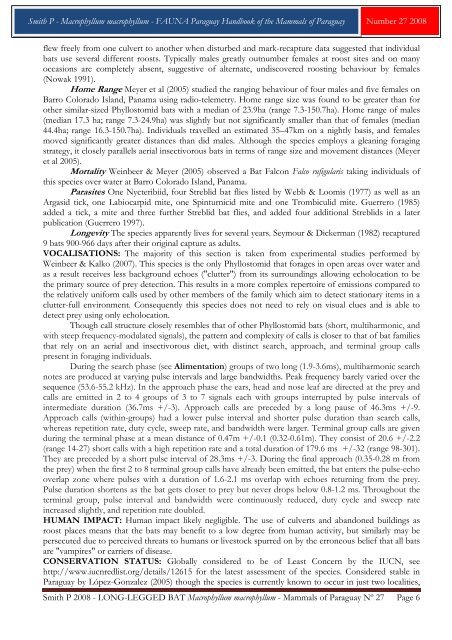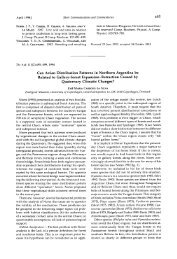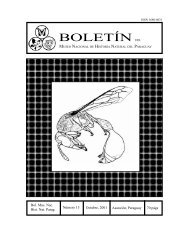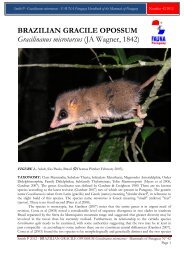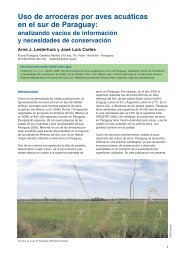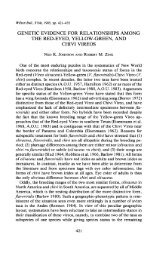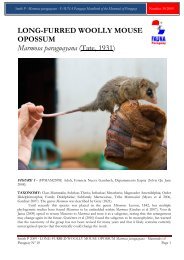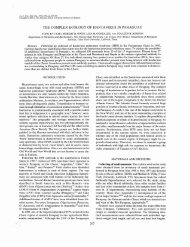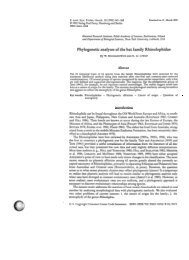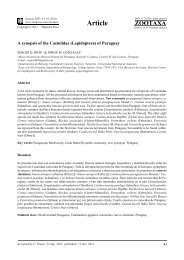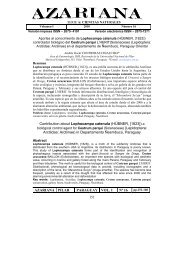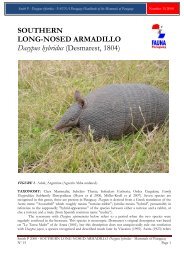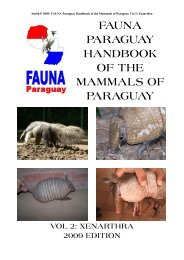LONG-LEGGED BAT Macrophyllum ... - FAUNA Paraguay
LONG-LEGGED BAT Macrophyllum ... - FAUNA Paraguay
LONG-LEGGED BAT Macrophyllum ... - FAUNA Paraguay
You also want an ePaper? Increase the reach of your titles
YUMPU automatically turns print PDFs into web optimized ePapers that Google loves.
Smith P - <strong>Macrophyllum</strong> macrophyllum - <strong>FAUNA</strong> <strong>Paraguay</strong> Handbook of the Mammals of <strong>Paraguay</strong> Number 27 2008<br />
flew freely from one culvert to another when disturbed and mark-recapture data suggested that individual<br />
bats use several different roosts. Typically males greatly outnumber females at roost sites and on many<br />
occasions are completely absent, suggestive of alternate, undiscovered roosting behaviour by females<br />
(Nowak 1991).<br />
Home Range Meyer et al (2005) studied the ranging behaviour of four males and five females on<br />
Barro Colorado Island, Panama using radio-telemetry. Home range size was found to be greater than for<br />
other similar-sized Phyllostomid bats with a median of 23.9ha (range 7.3-150.7ha). Home range of males<br />
(median 17.3 ha; range 7.3-24.9ha) was slightly but not significantly smaller than that of females (median<br />
44.4ha; range 16.3-150.7ha). Individuals travelled an estimated 35–47km on a nightly basis, and females<br />
moved significantly greater distances than did males. Although the species employs a gleaning foraging<br />
strategy, it closely parallels aerial insectivorous bats in terms of range size and movement distances (Meyer<br />
et al 2005).<br />
Mortality Weinbeer & Meyer (2005) observed a Bat Falcon Falco rufigularis taking individuals of<br />
this species over water at Barro Colorado Island, Panama.<br />
Parasites One Nycteribiid, four Streblid bat flies listed by Webb & Loomis (1977) as well as an<br />
Argasid tick, one Labiocarpid mite, one Spinturnicid mite and one Trombiculid mite. Guerrero (1985)<br />
added a tick, a mite and three further Streblid bat flies, and added four additional Streblids in a later<br />
publication (Guerrero 1997).<br />
Longevity The species apparently lives for several years. Seymour & Dickerman (1982) recaptured<br />
9 bats 900-966 days after their original capture as adults.<br />
VOCALISATIONS: The majority of this section is taken from experimental studies performed by<br />
Weinbeer & Kalko (2007). This species is the only Phyllostomid that forages in open areas over water and<br />
as a result receives less background echoes ("clutter") from its surroundings allowing echolocation to be<br />
the primary source of prey detection. This results in a more complex repertoire of emissions compared to<br />
the relatively uniform calls used by other members of the family which aim to detect stationary items in a<br />
clutter-full environment. Consequently this species does not need to rely on visual clues and is able to<br />
detect prey using only echolocation.<br />
Though call structure closely resembles that of other Phyllostomid bats (short, multiharmonic, and<br />
with steep frequency-modulated signals), the pattern and complexity of calls is closer to that of bat families<br />
that rely on an aerial and insectivorous diet, with distinct search, approach, and terminal group calls<br />
present in foraging individuals.<br />
During the search phase (see Alimentation) groups of two long (1.9-3.6ms), multiharmonic search<br />
notes are produced at varying pulse intervals and large bandwidths. Peak frequency barely varied over the<br />
sequence (53.6-55.2 kHz). In the approach phase the ears, head and nose leaf are directed at the prey and<br />
calls are emitted in 2 to 4 groups of 3 to 7 signals each with groups interrupted by pulse intervals of<br />
intermediate duration (36.7ms +/-3). Approach calls are preceded by a long pause of 46.3ms +/-9.<br />
Approach calls (within-groups) had a lower pulse interval and shorter pulse duration than search calls,<br />
whereas repetition rate, duty cycle, sweep rate, and bandwidth were larger. Terminal group calls are given<br />
during the terminal phase at a mean distance of 0.47m +/-0.1 (0.32-0.61m). They consist of 20.6 +/-2.2<br />
(range 14-27) short calls with a high repetition rate and a total duration of 179.6 ms +/-32 (range 98-301).<br />
They are preceded by a short pulse interval of 28.3ms +/-3. During the final approach (0.35-0.28 m from<br />
the prey) when the first 2 to 8 terminal group calls have already been emitted, the bat enters the pulse-echo<br />
overlap zone where pulses with a duration of 1.6-2.1 ms overlap with echoes returning from the prey.<br />
Pulse duration shortens as the bat gets closer to prey but never drops below 0.8-1.2 ms. Throughout the<br />
terminal group, pulse interval and bandwidth were continuously reduced, duty cycle and sweep rate<br />
increased slightly, and repetition rate doubled.<br />
HUMAN IMPACT: Human impact likely negligible. The use of culverts and abandoned buildings as<br />
roost places means that the bats may benefit to a low degree from human activity, but similarly may be<br />
persecuted due to perceived threats to humans or livestock spurred on by the erroneous belief that all bats<br />
are "vampires" or carriers of disease.<br />
CONSERVATION STATUS: Globally considered to be of Least Concern by the IUCN, see<br />
http://www.iucnredlist.org/details/12615 for the latest assessment of the species. Considered stable in<br />
<strong>Paraguay</strong> by López-Gonzalez (2005) though the species is currently known to occur in just two localities,<br />
Smith P 2008 - <strong>LONG</strong>-<strong>LEGGED</strong> <strong>BAT</strong> <strong>Macrophyllum</strong> macrophyllum - Mammals of <strong>Paraguay</strong> Nº 27 Page 6


